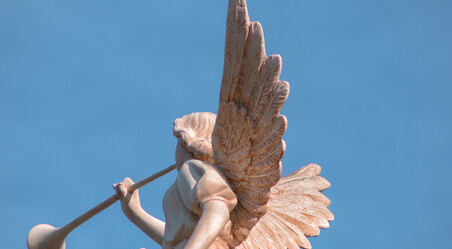The Father of the Big Bang Theory
Fr Joseph Laracy FAITH MAGAZINE May - June 2016
The Father of the “Big Bang” theory
Fr Joseph Laracy talks to Prof. D. Lambert who has recently produced a new book on the life of Mgr Georges Lemaître, famous for the “Big Bang” theory.
Dominique Lambert, professor at the Université de Namur in Belgium specialising in cosmology and the philosophy of science, recently completed a major biography of the great 20th century physicist, Mgr Georges Lemaître.
As we approach the 50th anniversary of Lemaître’s death in June, this interview, by Fr Joseph R. Laracy of Seton Hall University (South Orange, NJ, USA), gives readers of FAITH a unique glimpse into the life of this extraordinary Belgian priest.
Dominique Lambert explained first some of the background to Lemaître’s work: In 1927, Mgr Lemaître was the first scientist to explain what we call today the “Hubble law”, stating that the speeds of the far galaxies are proportional to their distances, in all directions of the universe. He explained that using a solution of Einstein’s equations of General Relativity corresponding to an expanding universe. In 1931, Lemaître introduced the “Primeval Atom” cosmology which can be considered as the prehistory of the Big Bang cosmology. In the latter, the universe begins by an initial singularity and its expansion is governed by gravitational attraction but also by a repulsion (described by the famous cosmological constant). This force is responsible for the fact that now the universe is accelerating. This is confirmed by more recent observation and the origin of this repulsion is now attributed to the “dark energy”. At that time, Lemaître was also one of the first who thought about fossil radiation. He believed that this radiation was made of cosmic rays. Since 1965 and the discovery of the Cosmological Microwave background (CMB) by Penzias and Wilson, we know that Lemaître was wrong. But, studying the properties of the trajectories of the cosmic rays detected at high altitude (the so-called Störmer Problem) he contributed to deep mathematical foundations for the theory of the Polar Aurorae.
Many people are surprised to know that a Catholic priest formulated the Big Bang hypothesis. How did his Christian faith influence his professional work as a scientist?
In fact Abbé Lemaître made an epistemological distinction between his science and his faith. He said that he followed “two paths to truth”. The reason was that he refused to reduce God’s action to a natural cause. For example, following Thomas Aquinas, whom he studied carefully at the Louvain Université in 1919, he insisted many times on the fact that creation (in the theological sense) cannot be confused with natural beginning (as it is described by physics). But, Georges Lemaître said sometimes that faith gave him optimism in his scientific career because he knew that the deep enigmas arising from the study of the universe had some definitive answers.
Did Lemaître ever encounter resistance or discrimination in scientific circles due to his faith and status as a Catholic priest?
Yes he did! Some scientists like Einstein and Hoyle suspected that he introduced his cosmology due to some religious motivation. But it was not true and this explains why Lemaître insisted so strongly on the distinction between science and faith. Long after his death, some physicists continue to suggest that Lemaître had apologetic motivations for introducing his Primeval Atom Hypothesis. What is true, and maybe paradoxical, was the fact that Georges Lemaître, a priest deeply rooted in his faith and his vocation, introduced for the first time a way to describe, not philosophically or theologically, but from physics, the notion of the beginning of the universe.
While much of his research focused on the field of cosmolog y, he was not limited to one branch of physics. What were some of his other interests?
Mgr Lemaître made many contributions outside of the field of cosmology: in the Theory of Spinors (after learning from Eddington and Elie Cartan’s books), in Classical Mechanics (three-bodies problem) and in Numerical Analysis (he invented many original methods: rational iteration, a kind of Fast Fourier Transform). He also worked on an original new kind of elementary arithmetic. His last scientific papers written in Berkeley in 1964 were dedicated to the three-bodies problem. He remained thus highly active till the end of his life in fields which are not restricted to cosmology. We have also to mention his deep interest in computers. He worked on the Vannevar Bush’s machine (differential analyzer) at the MIT in the 1930s and at the beginning of the 1950’s, in Louvain, he introduced the first computer, the Burroughs E101, and he programmed it inventing a new language.
Cardinal Mercier, Archbishop of Malines, ordained him to the priesthood. Tell us about their friendship.
Cardinal Mercier gave to Lemaître much freedom to allow him to continue to study physics and mathematics during his seminary time. Canon Jules Allaer, a close friend of Cardinal Mercier who was rector of the seminary (“Maison Saint Rombaut” in Mechelen) in which Lemaître entered in 1920, welcomed him in a fraternity called the “Friends of Jesus” (Les amis de Jésus). This fraternity was part of a special project of Cardinal Mercier who wanted to gather his priests in small groups aimed at sustaining their spiritual and sacerdotal lives. Within this fraternity, Lemaître made a vow of poverty and a vow by which he offered all his life to Christ (votum immolationis). Making long retreats with the “Friends of Jesus”, he also dedicated one hour each day after his Mass to silent worship. Cardinal Mercier was conscious, from their first meeting, of the exceptional scientific and spiritual personality of Georges Lemaître.
While his scientific ar ticles are widely available, did he do any writing in the area of theology or spirituality?
Lemaître was not a theologian. He did not write books on theology or on spirituality. But in 1936 he wrote a paper where he explained his view on the relation between science and faith. In fact he said that the unity between both is realised in the action of a person who is at the same time scientist and believer. His position looks like the one of Blaise Pascal, an author he liked to quote even in scientific contexts.
In his notebooks, written during his spiritual retreats, we can find something concerning his study of John Ruysbroeck, the famous Flemish mystic whose books he studied in an old version of Dutch. In the Bible he liked the Book of Isaiah which he quoted many times (“Deus absconditus" (Is, 45:15) and the Gospel of St John. During the First World War, the psalms were the principal source of his meditation.
What was he like as a person? Did he have hobbies?
He loved joking and he was very kind with his students and his colleagues even if they did not share his views and faith. Lemaître played a very important role welcoming foreign students in Louvain, especially Chinese students. He was a close friend of Fr Lebbe who played a very important role in the Catholic Church in China before the Second World War. He was the first Director of the Chinese House in Louvain in the 1930s. Lemaître had learned the Chinese language during his seminary time (1920–23).
Mgr Lemaître was a very good musician. He played the piano, especially Chopin and Bach. He was also interested in French literature and he dedicated some work to Molière. In fact he wanted to prove that another author could have written some of Molière’s plays.
Tell us about your book on Lemaître.
It’s based on Lemaître’s personal archives, on testimonies from his family and his collaborators, and also on original and recently discovered documents concerning his priestly life. It describes the evolution of his scientific ideas but also of his conception of the relationship between science and faith. In particular, I have tried to understand how this great scientist who became a close friend of Albert Einstein was also a priest, faithful to the teachings of the Catholic Church and deeply rooted in his spiritual and sacerdotal life. The book describes his personality, his family and his life as a professor at the Catholic University of Louvain (Leuven) as well as his relations with the Church (and with the Popes: Pius XI, Pius XII, St. John XIII and Bl. Paul VI).
D. L AMBERT, The Atom of the Universe. The Life and Work of Georges Lemaître (Preface by P.J.E. Peebles), Kracow, Copernicus Center Press, 2






